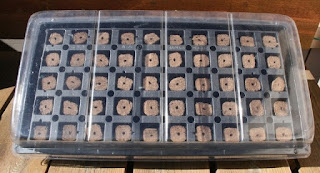It’s
just about time to sow seeds indoors and here are some ideas to get you started.
First, starting plants from seed is a great way to get exactly the variety of
peppers and tomatoes you want. In addition, tomatoes, peppers, eggplant require
long growing seasons and do best by starting them early indoors. Beans, peas,
radishes, lettuce and many other vegetables do best when sown directly into the
garden. You can start these vegetables indoors, but they typically don't transplant
well. You're better off to seed them directly.
In fact, many of these vegetable seeds can be planted in the ground in
early March.
Begin by selecting the
variety of tomato or pepper you want to grow. For best results, select a
quality seed from a local supplier.
Next, you'll need seed starting trays and
inserts. There are a number of inserts you can use to start your seeds,
including different sized trays as well as plugs such as Rapid Rooters.
You can
also choose peat pots in a variety of sizes to start your seeds in. Peat pots
can be planted directly, which reduces transplant shock.
Add a 2" or
7" dome to help keep in the moisture, while your seeds sprout. This setup
features a tray, Rapid Rooter insert and 2" dome.
Once you have your
starter containers, pick up some seed starting mix. Use seed starter, not
potting soil. You'll have much better results. It's a good idea to moisten the
seed starting medium before you sow your seed.
Check the back of the seed packet for sowing
instructions. The seed package will tell you how deep and how far apart to
plant the seeds. Heat mats help seeds germinate faster and root deeper, by
keeping the soil temperature constant. Even if the room cools off at night, the
soil stays warm and seeds will sprout faster.
Once your seeds are up and have
grown two or more sets of leaves, it may be time to add some supplemental
lighting. An easy way to do this is to purchase a grow system like Jump Start.
This system comes complete with a stand and T5 grow light. You can also buy T5
grow bulbs individually, as well as T12 grow bulbs that will fit your shop
light fixtures. Providing adequate lighting is one of the most aspects of
growing strong, healthy seeds indoors.
Feed your seedlings with a mild liquid fertilizer once they've developed
three or more sets of true leaves. As your plants grow, ruffle them once a day
with your hand. This helps them grow stocky and strong. As for timing, the
first or second week in March is just about right. Starting your own seeds is a
very rewarding way to extend your gardening season.










No comments:
Post a Comment